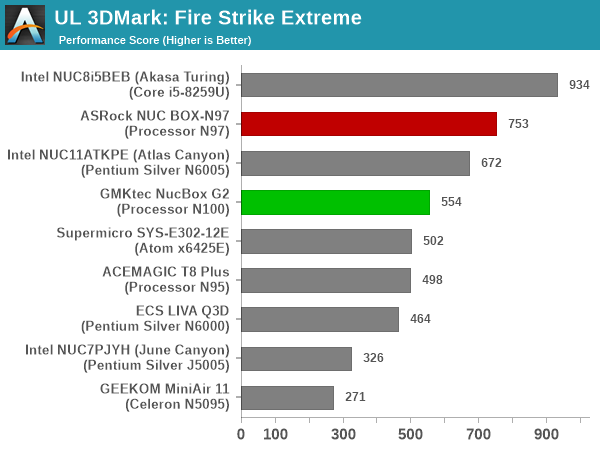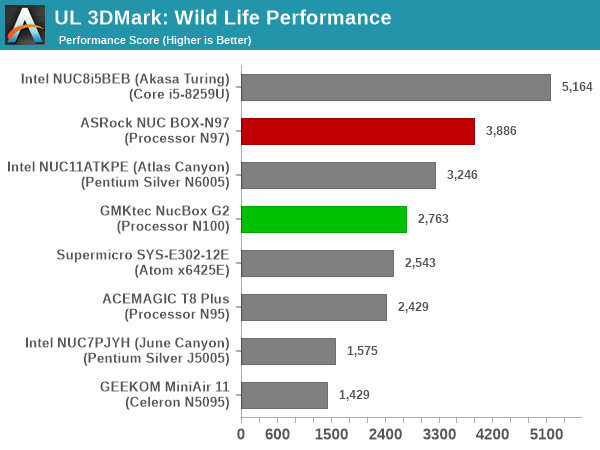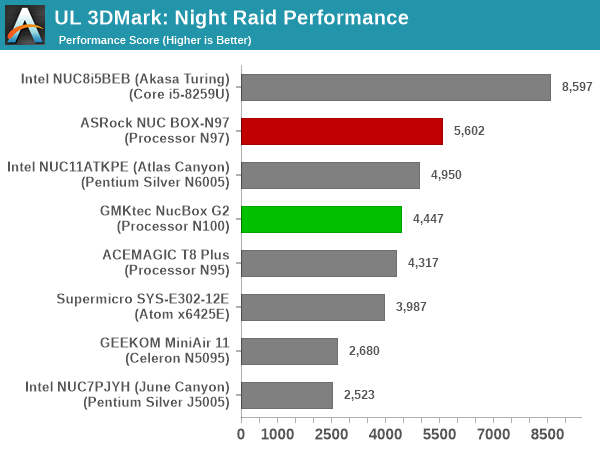ASRock Industrial NUC BOX-N97 and GMKtec NucBox G2 Review: Contrasting Compact ADL-N Options
by Ganesh T S on October 6, 2023 9:45 AM EST- Posted in
- Systems
- UCFF
- Mini-PC
- ASRock Industrial
- Alder Lake-N
- micro-PC
- GMKtec
GPU Performance: Synthetic Benchmarks
The integrated GPU in Alder Lake-N is a pared-down version of the one used in Alder Lake. Both the N97 and N100 have the 24EU version, but the N97 clocks it at 1.2 GHz compared to the 750 MHz N100 configuration. However, DDR4 vs. LPDDR5 may also impact GPU performance. Keeping these aspects in mind, the GPU performance has to be evaluated in the context of each workload. We put the systems through some standard 3D workloads to get an idea of what they have to offer for GPU-intensive tasks. Prior to that, a detailed look at the capabilities of the GPU is warranted.

NUC BOX-N97 AIDA64 and GPU-Z GPU Information
The 1200 MHz boos clock in the NUC BOX-N97's iGPU allows for pixel and texture fillrates of 14.4 Gpix/s and 28.7 GTex/s despite the DDR4 memory limiting memory bandwidth to 76.6 GBps.

GMKtec NucBox G2 GPU-Z GPU Information
On the other hand, the 750 MHz clock of the N100's iGPU lowers the pixel and texture fillrates despite the massive jump in the memory bandwidth to 153.2 GBps.
GFXBench
The DirectX 12-based GFXBench tests from Kishonti are cross-platform, and available all the way down to smartphones. As such, they are not very taxing for discrete GPUs and modern integrated GPUs. We processed the offscreen versions of the 'Aztec Ruins' benchmark.


The N97's faster iGPU clock enables a healthy lead for the NUC BOX-N97 over the other systems in both cases.
UL 3DMark
Four different workload sets were processed in 3DMark - Fire Strike, Time Spy, Night Raid, and Wild Life.
The Fire Strike benchmark has three workloads. The base version is meant for high-performance gaming PCs. It uses DirectX 11 (feature level 11) to render frames at 1920 x 1080. The Extreme version targets 1440p gaming requirements, while the Ultra version targets 4K gaming system, and renders at 3840 x 2160. The graph below presents the overall score for the Fire Strike Extreme and Fire Strike Ultra benchmark across all the systems that are being compared.
| UL 3DMark - Fire Strike Workloads | |||

The Time Spy workload has two levels with different complexities. Both use DirectX 12 (feature level 11). However, the plain version targets high-performance gaming PCs with a 2560 x 1440 render resolution, while the Extreme version renders at 3840 x 2160 resolution. The graphs below present both numbers for all the systems that are being compared in this review.
| UL 3DMark - Time Spy Workloads | |||

The Wild Life workload was initially introduced as a cross-platform GPU benchmark in 2020. It renders at a 2560 x 1440 resolution using Vulkan 1.1 APIs on Windows. It is a relatively short-running test, reflective of mobile GPU usage. In mid-2021, UL released the Wild Life Extreme workload that was a more demanding version that renders at 3840 x 2160 and runs for a much longer duration reflective of typical desktop gaming usage.
| UL 3DMark - Wild Life Workloads | |||

The Night Raid workload is a DirectX 12 benchmark test. It is less demanding than Time Spy, and is optimized for integrated graphics. The graph below presents the overall score in this workload for different system configurations.

The relative performance of the different systems doesn't change with workload or resolution. The 1.2 GHz iGPU in the NUC BOX-N97 takes the honors despite the weaker DDR4 memory subsystem. The Atlas Canyon NUC based on Jasper Lake manages to sneak in-between the NUC BOX-N97 and the NucBox G2 due to its higher EU count and 900 MHz clock, despite its previous-generation architecture.










20 Comments
View All Comments
markiz - Tuesday, October 17, 2023 - link
Is support really at all important, or at all, with machines like these?I've had a couple of PC over the years and they all lasted 10+ years with no failers of any compononets.
Nor as a home user have I ever considered BIOS update.
I imagine in business settings it's much different.
hubick - Sunday, October 8, 2023 - link
"and soldered RAM is not being met with as much derision as before."this is where I stopped reading this article.
meacupla - Sunday, October 8, 2023 - link
It's 12GB LPDDR5 on a 6W Celeron. It's fine.Even 8GB works fine at 1440p on that CPU.
4K, you might want 16GB.
mode_13h - Monday, October 9, 2023 - link
> It's 12GB LPDDR5 on a 6W Celeron.Did you see the power consumption measurements? These things don't even *idle* at 6W!
mode_13h - Sunday, October 8, 2023 - link
> The key aspect ... is the presence of the 'In-Band ECC' option.> ...
> We confirmed ... that this option would not be removed in a future BIOS version
> Apparently, Intel has decided to allow In-Band ECC as an official feature of the ... N97.
Excellent! Thank you!
If only they had used DDR5, this might be my next mini-PC!
> MemTest86 hang during memory testing of a known faulty SODIMM
> instead of reporting errors).
LOL, wut? I hope that's a Memtest86 bug, and not just what happens when you get memory errors with IB-ECC!
ganeshts - Sunday, October 8, 2023 - link
Faulty SODIMMs can't guarantee only one- or two-bit errors. There could be more.The likely explanation for the hang is that IB ECC generates an ECC mismatch interrupt internally to the processor, and MemTest86 is not able to handle it.
MemTest86 will eventually need to add support for IB ECC interrupt handling / error status readouts.
mode_13h - Sunday, October 8, 2023 - link
Thanks for the review & replying to me.> Faulty SODIMMs can't guarantee only one- or two-bit errors. There could be more.
Okay, I sort of assumed you had some idea of how many errors the DIMM had, like based on doing a memtest scan with ECC disabled. I've seen my share of DIMMs with only a handful of bad cells, so I assumed it was one of those.
> MemTest86 will eventually need to add support for IB ECC interrupt handling / error status readouts.
Yes. Sounds like a feature they need to add. Is this the memtest variant from PassMark Software?
ganeshts - Monday, October 9, 2023 - link
Yes, I am using the PassMark variant.I have screenshots from mem testing the same SODIMM with the NUCS BOX-1360P/D4 (when they had the IB ECC feature enabled in the BIOS):
https://www.anandtech.com/show/18732/asrock-indust...
mode_13h - Monday, October 9, 2023 - link
Submit a bug report on it For Great Justice!NextGen_Gamer - Tuesday, October 10, 2023 - link
@Ganesh T S - I don't think those memory bandwidth figures and specs are correct. GPU-Z is known to not have good support for Intel's lower-end line. I know this personally as an owner of the Intel NUC11ATKPE ("Jasper Lake"). Intel's ark website shows that Alder Lake-N has a single memory channel (64-bit). Running at its fastest, so either DDR5-4800 or LPDDR5-4800, would be 38.4GB/sec of bandwidth. That tracks and make sense with what Intel says their 13th-gen Core series max bandwidth is, being dual-channel DDR5-5600, at 89.6GB/sec.Alder Lake-N running in its single-channel DDR4-3200 config then should be only 25.6GB/sec.